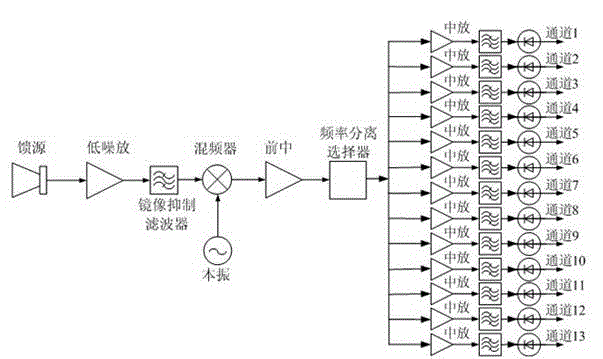Satellite-bone low-noise 13-channel V wave band receiver
A low-noise, receiver technology, applied in electrical components, transmission systems, etc., can solve the problems of satellite resource waste, application difficulties, quality, volume and power consumption, etc., and achieve low weight and power consumption, and high system integration Effect
- Summary
- Abstract
- Description
- Claims
- Application Information
AI Technical Summary
Problems solved by technology
Method used
Image
Examples
Embodiment Construction
[0018] The embodiment of the present invention provides a space-borne low-noise 13-channel V-band receiver, such as figure 1 As shown, it includes a polarization selective feed source, a V-band low noise amplifier, a mixer, a frequency separator, an intermediate frequency processing unit, a detection circuit and a low frequency processing unit;
[0019] The polarization selection feed receives a noise signal and separates the H polarization component from the noise signal, and the V-band low noise amplifier is connected to the polarization selection feed and performs low The noise is amplified and output to the mixer, and the mixer generates an intermediate frequency signal after down-converting the input signal, and the frequency separator is connected to the mixer and separates the intermediate frequency signal into 13 different centers Frequency, intermediate frequency signals of different bandwidths, the 13 channels of intermediate frequency signals are respectively amplif...
PUM
 Login to View More
Login to View More Abstract
Description
Claims
Application Information
 Login to View More
Login to View More - R&D
- Intellectual Property
- Life Sciences
- Materials
- Tech Scout
- Unparalleled Data Quality
- Higher Quality Content
- 60% Fewer Hallucinations
Browse by: Latest US Patents, China's latest patents, Technical Efficacy Thesaurus, Application Domain, Technology Topic, Popular Technical Reports.
© 2025 PatSnap. All rights reserved.Legal|Privacy policy|Modern Slavery Act Transparency Statement|Sitemap|About US| Contact US: help@patsnap.com



